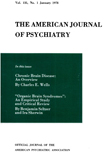The psychological organization of depression
Abstract
On the basis of the intensive psychotherapy of about 40 depressed patients over the course of two decades, the authors describe three premorbid types of depressive personality: 1) one based on a "dominant other" relationship, 2) one based on a "dominant goal," and 3) one that is a form of character structure or personality disorder. They also describe typical childhood experiences of depressive adults and discuss their theory of the nature of depression as a human experience. They characterize depression as a limitation of alternate ways of thinking and as self-inhibition from new experiences.
Access content
To read the fulltext, please use one of the options below to sign in or purchase access.- Personal login
- Institutional Login
- Sign in via OpenAthens
- Register for access
-
Please login/register if you wish to pair your device and check access availability.
Not a subscriber?
PsychiatryOnline subscription options offer access to the DSM-5 library, books, journals, CME, and patient resources. This all-in-one virtual library provides psychiatrists and mental health professionals with key resources for diagnosis, treatment, research, and professional development.
Need more help? PsychiatryOnline Customer Service may be reached by emailing [email protected] or by calling 800-368-5777 (in the U.S.) or 703-907-7322 (outside the U.S.).



